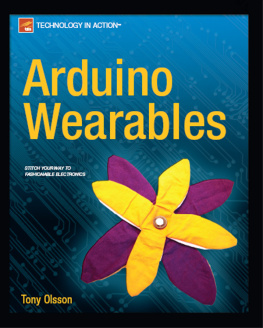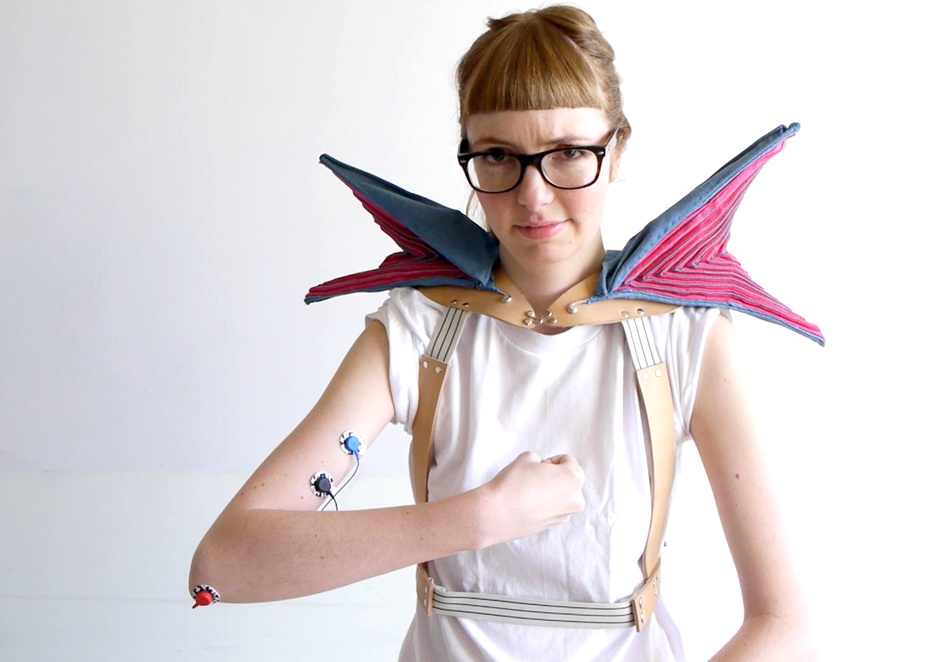To Red, for helping us see that our work with technology is ultimately about people.
About The Book
Figure 1. Monarch, a muscle-triggered kinetic textile created by the Social Body Lab
Our bodies are our primary interface for the world. Interactive systems that live on the body can be intimate, upfront, and sometimes quite literally in your face. They sit close to your skin, inhabit your clothing, and sometimes even start to feel like part of you. This makes wearable electronics an exciting, challenging, and inspiring area to work in.
On one level this book is about how to make wearable electronics. It will introduce you to the tools, materials, and techniques necessary to create interactive electronic circuits and embed them in clothing and other things that can be worn.
On another level, this book is asking you: Whats next?
Were living in a moment where wearable technologies are just starting to become a part of our everyday lives. They live on our wrists and in our glasses. They track our activities and transport us into virtual worlds. But this is just the beginning. There is still a lot that has yet to be revealed.
This book is inviting you to join the conversation about the future of wearable and body-centric technologies. What do we need? What do we want? And what should be avoided?
In the last 1015 years, the technology that lives in our pockets has dramatically transformed. In the next decade, we can expect to see great strides in the development of the technology that lives on our bodies and in our clothes. Its a good time to ask questions and express opinions. This book will hopefully help you get started with that.
Who This Book Is For
This book is for people who want to roll up their sleeves and make some wearable electronics. This includes students, researchers, hackers, makers, fashion designers, engineers, industrial designers, developers, costume enthusiasts, artists, and textile mavens.
There are two perspectives from which you might be approaching this book.
The first: you know some stuff. Theres a broad range to this. Maybe youre someone who has used an Arduino to blink an LED at a workshop once upon a time. Or maybe you run a design firm that produces massively robust interactive installations in museums and now youve got a client who wants you to generate a prototype thats wearable. Either way, you know enough to have a sense of what universe youre in. This book will help you build upon what you already know and might even lead you into some areas you didnt expect!
The second: when it comes to electronics and programming, youre a bit of a n00b. Maybe youre a fashion designer that realizes that interactivity in clothing is something you should wrap your head around. Or perhaps youre a sociologist who is developing a data-collection system that includes sensors that live on the body. Or maybe youre an artist with a newfound interest in self tracking. In any case, there are likely many things in this book that you may not have heard of before. If youre in this category, take this advice: be brave. Its OK if things are new to you or if you dont understand it on the first go. This book might be your gateway to a whole new list of things you didnt realize you wanted to learn. Stick with itits interesting stuff!
What You Need to Know
This book covers most of the basics, but it does assume that you understand soldering and basic hand sewing. If either of these things are new to you, check out for resources where you can learn more. It is possible to complete most of the examples in the book with one or the other, but I do encourage you to learn both.
How This Book Is Organized
This book will take you on a journey that starts with circuit basics and ends with how to make interactive wireless wearables. In between, youll learn about materials, microcontrollers, sensors, and actuators, and how these things fit into the world of wearable electronics. Here is what lies ahead:
This chapter introduces you to circuit basics and then will show you six different ways to build the same circuit using different conductive materials.Here you will take a deep dive into the range of conductive materials that we can use to construct circuits.On, off, and beyond! This chapter provides an overview of switch basics and explains how to create your own.This chapter reviews the different electronic textile toolkits that are available for use in your wearable electronics projects.Making a circuit is one thing, but wearing it is another. This chapter goes through factors to consider when designing wearable electronics.This is where the brains come in. This chapter provides an introduction to both the hardware and software aspects of getting up and running with microcontrollers.Sensors are what microcontrollers use to listen to the physical world. This chapter provides an introduction to the basics of working with sensor data and presents a variety of sensors that are useful in the wearable context.Actuators make things happen! From light to sound to motion, this chapter introduces you to actuators that can be employed in your wearable electronic designs.Time to bust out! This chapter introduces three approaches for wireless communication, meaning your project can send and receive data without being tied down.This provides an overview of the electronics and sewing tools that you might need for your studio, workshop, or lab.Power it up! Here youll find details of battery options for your wearable electronics projects.Want to learn more? Heres a list of resources that will take you above and beyond whats covered in this book.This is a selection of materials and processes that might help you make your wearables happen.Here youll find a more comprehensive list of microcontroller options to use in your wearable electronics projects.
About the Title
Make: Wearable Electronics does indeed cover how to make electronics that are wearable. More broadly, it provides a non-traditional approach to constructing electronic projects. The tools and techniques that are covered can also be applied to textiles, tapestries, toys, and more!
About Experiments and Projects
Throughout the book, well walk through experiments that will get you going and take a look at real-world projects that will serve as inspiration. A deliberate gap has been left between the two.
Some wearable electronics and e-textile books show you exactly how to build a particular project. This is not one of them. Instead, this book provides the building blocks that will help bring your own ideas to life.
About the Examples
Here are some technical notes about the examples presented in this book:
Connections Most of the example circuits presented in this book can be created using alligator clips. Alligator clips can always be replaced by conductive thread, soldered wires, or other conductive materials as desired. Power All of the analog circuits can be powered using CR2032 batteries. Except where noted, the microcontroller circuits can be powered either by 1,000 mAh rechargeable lithium polymer batteries or via the microcontrollers USB connection. For alternative power options, see . Code All code can be found here: https://github.com/katehartman/Make-Wearable-Electronics

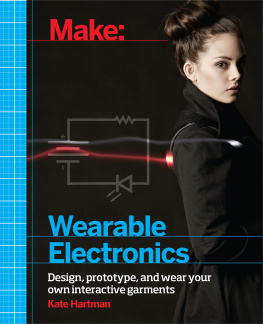
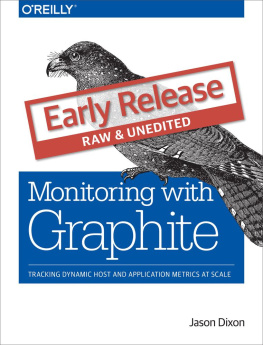
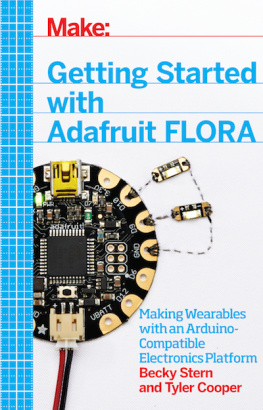





![Jimmy Song [Jimmy Song] - Programming Bitcoin](/uploads/posts/book/119685/thumbs/jimmy-song-jimmy-song-programming-bitcoin.jpg)
